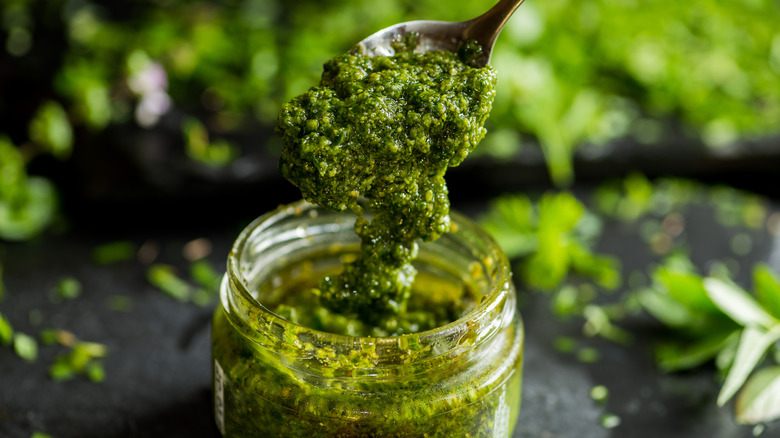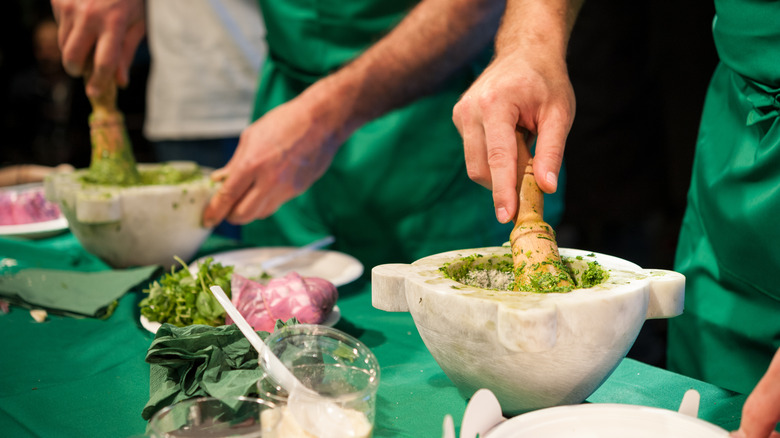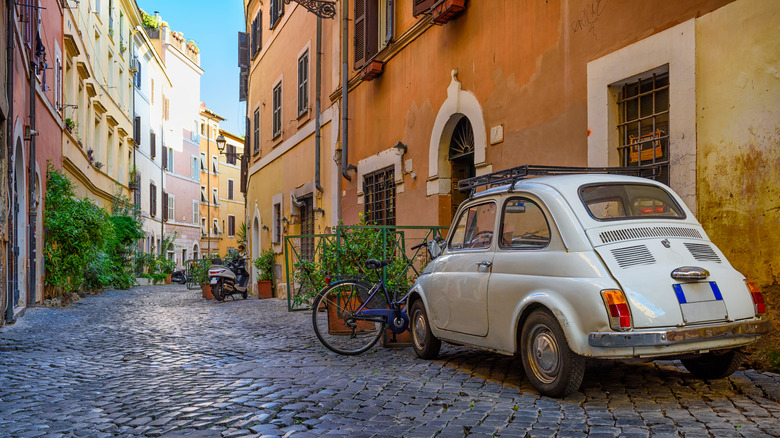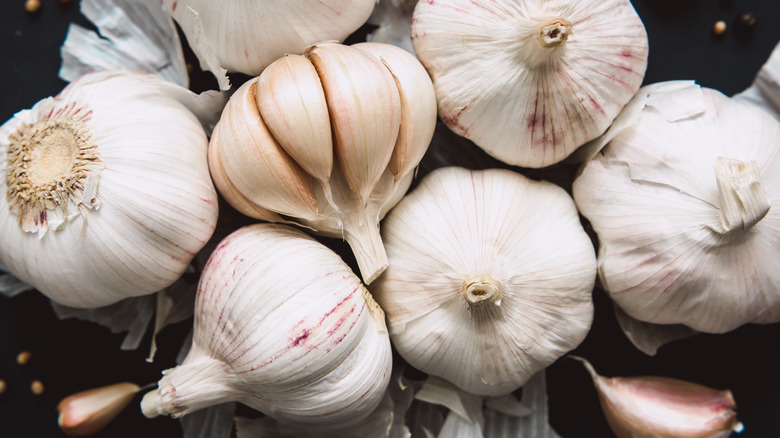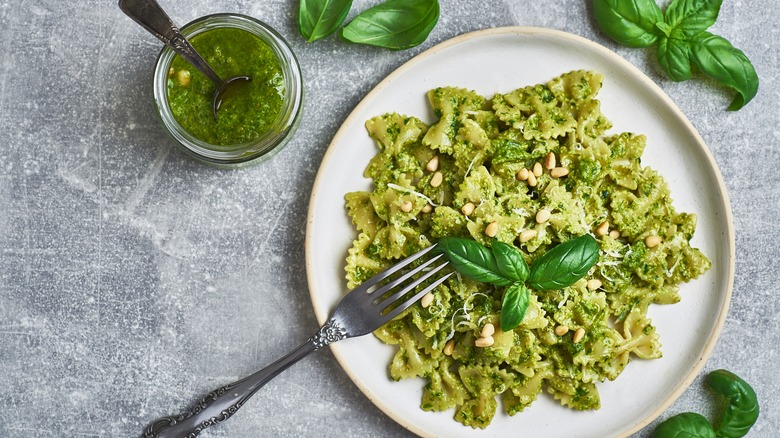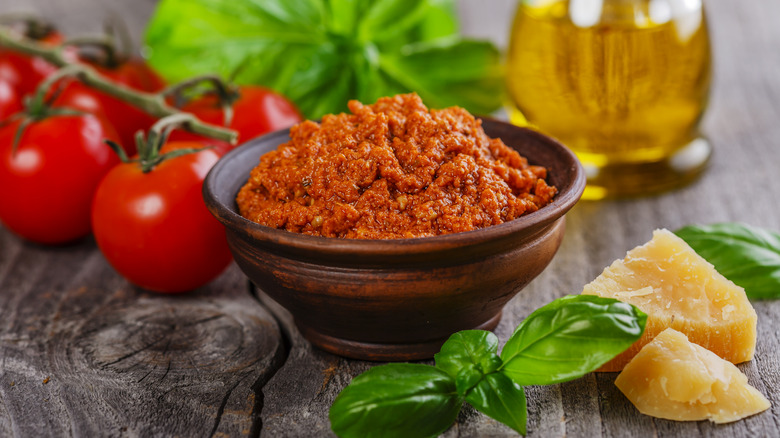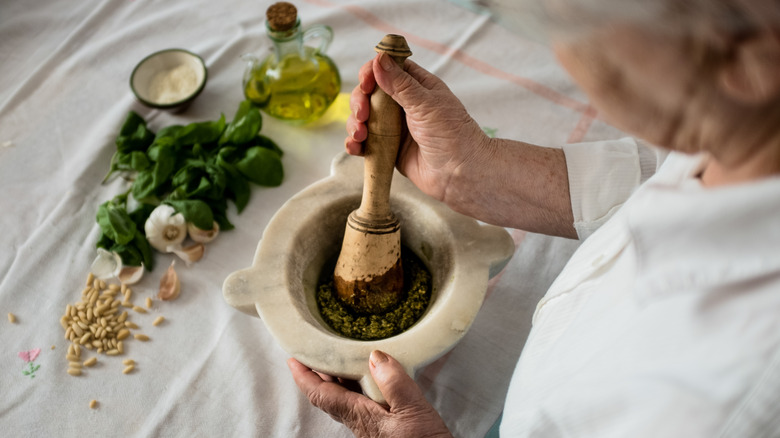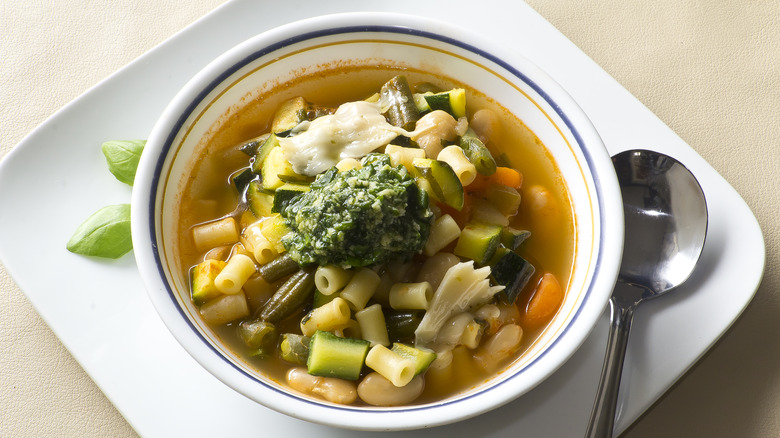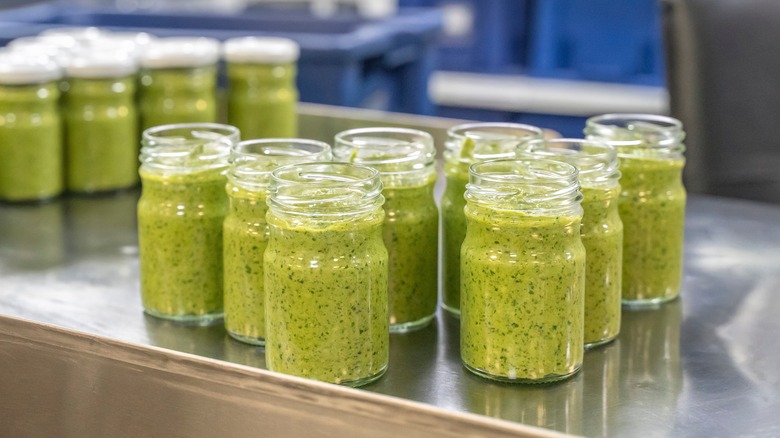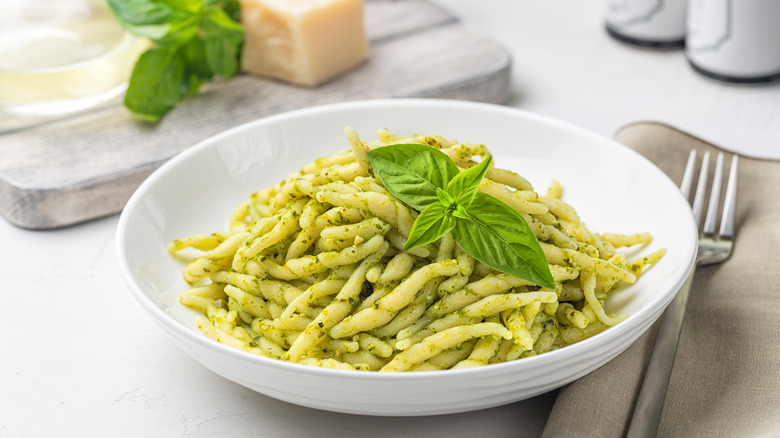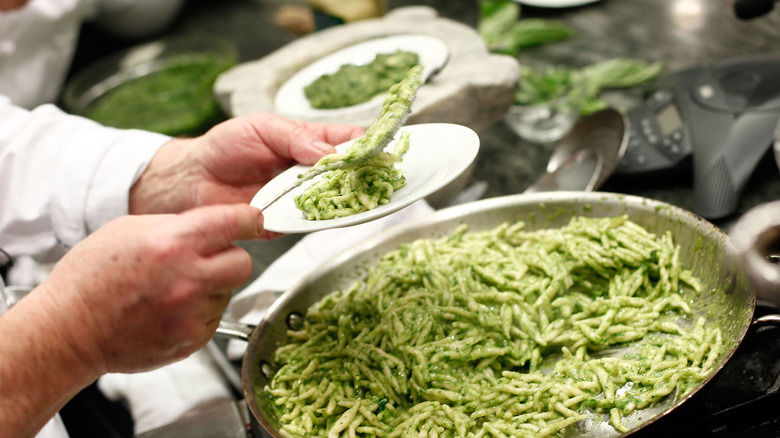The Ancient Roman Roots Of Pesto
Whether you add it to your chicken, throw it on a sandwich, or eat it straight from the jar with a cracker, there's no denying that pesto is delicious in all its simplicity. Requiring only a handful of basic ingredients, most pesto recipes are accessible and simple for even the most novice of home cooks. If you have pine nuts, basil, parmesan, and a few other pantry ingredients, plus a food processor or a mortar and pestle, you're well on your way to making fresh pesto.
However, while pesto is pretty simple, its history is not. Pesto can be traced back centuries, with the Italian condiment's roots stretching to ancient Rome. That said, the first Roman pesto was a little different from what we buy at the grocery store today, with pesto evolving over time and location. In fact, today, you can find different variations of pesto across Europe, even if the Genoese version is what most think of as pesto.
Pesto as we know it today originated in Genoa
If you want to trace the origins of the pesto that you'd get at the grocery store or the pesto that would result from following the average pesto recipe that you might find online, you'll trace your way back to Genoa, where the most recognizable historical version of pesto got its start. Traditional pesto made with pine nuts, cheese, olive oil, and basil was invented in Genoa, Italy, where the first recipe for the modern equivalent of pesto was written during the 1800s in a cookbook titled "Genoese Cooking."
Genoa and the larger region of Liguria, in general, are known for taking their food seriously, and pesto is no exception. Genoese-derived pesto incorporates ingredients that you'd be hard-pressed to find elsewhere. Sure, you could pick up some parm at your local grocery store and swing by the produce section for some basil. However, Genoese basil is specifically considered one of the best varieties money can buy for its unique flavor. Similarly, olive oil from Liguria boasts a one-of-a-kind flavor, as does the regional parmesan. Just like the first record of modern pesto can be found in Genoese literature, so can the first record of parmesan.
Pesto's predecessor is the Roman moretum
It's not really fair to say that pesto was entirely invented in Genoa in the 1800s, even if the first written recipe for modern pesto is a product of 19th-century Genoa. While that recipe put down a list of ingredients and a process for the first time, humankind has been grinding up nuts, leaves, and oil into various concoctions for much longer. Many believe that pesto's origins can actually be traced back further than Genoa in the 1800s to Roman times, in the dish known as moretum.
This dish shares a lot of similarities with modern pesto. To make it, the Romans would have mixed cheese and salt with a variety of herbs, salt, pepper, and oil. The main difference, though, comes in the specific ingredients used. Whereas modern home cooks stick to their parmesan and basil, the Romans might have used mint, parsley, or coriander for their herbs and might have used a fresh cheese rather than an aged variety. The Romans may have originally combined only garlic and basil, leaving out the cheese, to create a similar mixture used on meat or fish.
A Roman recipe for moretum can be found in ancient poetry
Suppose you want to make your own moretum because, after all, it's best to make your own pesto, whether you're going the modern or the contemporary route. You can find a recipe for this dish in ancient poetry and other literature. In one instance, a poem titled "Moretum" or, when translated, "The Salad," can be partially credited to the Roman poet Virgil. The poem follows its subject as he gathers the ingredients needed for the dish and then prepares them using a mortar before eating the resulting concoction on bread.
In Roman author Columella's "De Re Rustica" or, translated, "On Agriculture," he likewise details how to make moretum. However, his description is more similar to a modern recipe than Virgil's poem, as Columella gives a list of ingredients and specific instructions on combining them before serving the mixture topped with oil. Whatever ancient recipe you follow, you'll find that the result is a cheesy, herby mixture that's enjoyable when used much in the same ways as you might contemporary pesto.
Genoa originally developed another take on pesto, agliata
Between the Roman moretum and the Genoese pesto that we know and love today, another form of pesto or something that's at least pesto-adjacent existed, also developed in Genoa, with recordings of the recipe traced back to the Middle Ages. This variant was a mixture of nuts and garlic, with no basil, known as agliata. The recipe also called for walnuts instead of pine nuts. Agliata is very similar to prior Roman dishes, like moretum, but unlike the Roman pesto, agliata is still eaten today, particularly around Liguria.
Aglio — the word for garlic in Italian — is typically used as an accompaniment for fish or meat dishes. Some believe that the dish, with its preservative properties, garlic makes a great preservative, preventing bacteria growth on chicken and other meats. It was said to be eaten by sailors, who were the ones to add basil to the mixture, getting us closer to the modern-day take on pesto.
Modern pesto makes its mark, finally including basil
As mentioned, the first modern pesto recipe was published in the mid-1800s. "Cuciniera Genovese," or "Genoese Cooking" was written by Chef Giovanni Battista Ratto. While Ratto's recipe results in a dish fairly similar to what you might see at the grocery store, thanks to Ratto's unique addition of basil, there are still a few differences.
While pine nuts are the go-to option for your pesto recipes today, Ratto allowed for the inclusion of walnuts instead of pine nuts. Additionally, he made note that you didn't have to necessarily use basil, even if it was his preference and what makes his recipe stand out. He allowed for other seasonal herbs if needed. Additionally, Ratto's recipe didn't use parmesan or pecorino as the dish's cheese base. Instead, the recipe called for Dutch cheese, which was readily available in Italy at the time. Butter was also added for creaminess.
Other regions of Italy have their own pesto
While traditional pesto is forever connected to Genoa, other regions of Italy do boast their own versions of pesto that are somewhat similar to the Genoese take but with a few unique twists. For example, one of the most prominent interpretations comes from Sicily, where you'll find pesto rosso or red pesto.
Sicilian pesto still has the garlic, the basil, the nuts, the olive oil, and the cheese. However, it swaps out the pine nuts for almonds. Additionally, instead of just using parmesan or pecorino, this pesto incorporates both parmesan and ricotta. The biggest difference, though, is the main ingredient that sets this pesto apart and gives it its red hue — the tomatoes.
The result is an extra-creamy pesto that works anywhere that you might use traditional green pesto, on fresh bread, on pasta, wherever. Another similar pesto from Trapani, Sicily, is called pesto alla Trapanese, which follows the same recipe but leaves out the ricotta.
The word pesto has many uses
One reason why there are so many different variations on pesto? It can partially be chalked up to etymology. The word pesto traditionally just referred to any dish that you made using a mortar and pestle, as pesto is a form of the Genoese word meaning to pound.
Since there are so many different dishes one could feasibly make by pounding a mixture of ingredients in a mortar, there are also a few different dishes that are either called pesto or that are connected to the history of pesto in some way, regardless of how close the ingredients lists actually are.
To follow the etymology wormhole even further, if you look past the Genoese language, you can find that pesto-like words existed in ancient Latin as well. According to Vocabulary, "The origin of pestle is the Latin word pistillum, which means "pounder." This can help you remember that the pestle is the pounder."
Over time, various different forms of pesto arose depending on the ingredients that were available seasonally and geographically, but if the result could be spread on bread or meat, eaten on pasta, or for some similar use, it was called pesto.
There's even a French pesto
Similarly to how the Romans and then Italians ended up applying the word pesto to any dish that was pounded with a mortar and pestle, so did the French, and the resulting dishes are pretty similar. The French took the Latin word pestare or crush and turned it into pistou. Today, pistou is not as well known as pesto, but if you like pesto, chances are likely that you'll find pistou tasty, too.
Pistou is made by crushing, using a traditional mortar and pestle or a food processor, basil, garlic, and oil together into a pasty sauce that is then used as a condiment. It's often added to soup or seafood. Unlike pesto, though, pistou does not contain any nuts and, traditionally, did not contain any cheese. Some recipes today will add it in, but some still like to go the traditional route, especially if they're looking for a vegan take on pesto.
Pesto's fairly new to the United States
There were many different Italian dishes that made their way to the United States in the early 20th century due to immigration. While many of these dishes eventually received an American twist, so much so that they might not even resemble their Italian predecessors at this point, pesto has remained pretty well-connected to its roots.
Americans first tried pesto in the 1940s and 1950s. However, the imported ingredient didn't really get a lot of love at first, not like other Italian favorites at the time. In the 1970s, pesto became more popular as it was made fresh, stateside, rather than imported. Still, even then, it wasn't as well-known as it is today. Not until a few decades later when pesto began appearing in popular cuisine in the 1990s. Now, pesto is nearly a pantry staple, appearing in a variety of pastas and pizzas, whether you're dining out or at home.
Pasta is the most traditional place to put your pesto
There's no denying that there are near-endless ways to use pesto, but the most traditional of them all? In or on your pasta. In fact, while red sauce is the go-to pasta sauce in the United States, pesto is one of the most popular pasta topping options in Italy. In Liguria, you're likely to spot pesto atop trofie. Trofie is pasta that comes in a small, twisted shape, as is the case with the regional dish, trofie pasta Liguria, which combines the pasta with pesto, potatoes, and green beans.
Beyond regional specialties, though, pesto finds its way into any place you might normally spot another sauce, like in a classic lasagna recipe. If you're making a traditional pesto pasta dish at home, go all the way with your adherence to tradition by using a mortar and pestle rather than a food processor or blender and with Genoese basil. No Genoese basil? Whatever basil you use, make sure it's in good condition, harvested at the right time and, preferably, not grown in full sun; otherwise, your pesto may blacken.
Pesto is nominated for inclusion on the UNESCO Intangible Cultural Heritage list
The UNESCO Intangible Cultural Heritage list recognizes customs and cultural acts or items that represent a community and which are often at risk of disappearing due to lack of interest, attention, or tradition. Among other things, the list includes artworks, performances, instruments, garments, and, of course, food. Because of this, it should be no surprise that someone nominated authentic Genoese pesto for inclusion on the UNESCO Intangible Cultural Heritage list. Responsible for this was a restauranteur and pesto enthusiast Roberto Panizza. He also founded the Palatifini Association, which, among other initiatives, hosts the pesto-making world championship.
While it's easy to think that pesto is common enough that it wouldn't need the heritage list's recognition and protection, Panizza claimed that the world's versions of pesto are a far cry from the traditional pesto found in Italy and that tradition was worth protecting. While pesto has not made the UNESCO list just yet, the bid for inclusion has gained support from regional councils throughout Italy.
